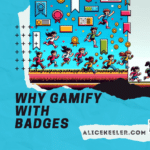I notice that some teachers I chat with are confused about how hashtags work. Here is my basic guide to hashtags.
#Hashtag
A hashtag starts with the pounds symbol (#) followed by a single word (or words smashed together). No spaces.
Tag or Topic
The hashtag is a tag you might code your tweet with. Is your tweet about math use #math. Are you tweeting about 3D printing? You can tag that tweet with #3Dprinting. Talking about teaching? #teach or #teacher or #teaching. Are you sharing a lesson plan? #lessonplans
The hashtag is converted to a live link and is blue in the tweet. This sticks out. Tagging your tweet with a hashtag helps people to scroll their Twitter stream to easily find things on topics they are interested in.
In “one word”, what is the topic of your tweet? Make a hashtag out of that and include it.
Note: You can smash words together if it really needs to be 2 words. Example #lessonplans

Notice in the above sample tweet the hashtag of #CCSS is included in the tweet. I instantly know this tweet is about Common Core even though it is not explicitly mentioned in the tweet itself.
Not a Sentence
A hashtag is not a sentence. A hashtag is not your tweet. When adding a hashtag, boil you tweet down to the essential word or topic that the tweet is about.
Audience
A hashtag is also used to target your tweet at a particular audience. Who would be interested in this tweet, demographic wise?
Conference
One of the best uses of Twitter hashtags is when you are at an event. Everyone at the event includes the event hashtag in their tweets. This allows anyone at the event to find the tweets that are from the event. Today the Google I/O event is going on. Since I can not get into Google I/O, I can virtually be there by reading the tweets of people who are there. I simply look for the hashtag #io15.
Event hashtags allow me to see tweets from people I do not normally follow. This is a great way to meet new people at an event. I find people who are tweeting out interesting and helpful things at the event and follow them. Since we are at the same event, oftentimes I am able to meet these tweeps (Twitter peeps). In person, we instantly have interesting conversations and connections. Leave the awkward “hi, I’m Alice. Where are you from?” behind. Instead “I loved your tweet about ____, I am thinking of doing the same thing. Do you have any suggestions?”
Event hashtags also enhance a keynote or conference presentation. Suddenly the keynote is interactive. People are not just tweeting out the best lines from the speaker but adding resources, links, ideas, questions to the mix.
School
If your school has a hashtag, use the school hashtag in your tweets about the school. Parents, students, community members can join in your school pride by looking up the hashtag. Tweeting the awesome things going on in your classroom, at your school or in your district provides transparency to the community and helps people to realize this is the place to be. The school hashtag is also a great way to get announcements out. Connect with people interested in your school by following your school hashtag.
Subject Area
Want to connect with other teachers in your grade level or subject area? Try tagging your tweets with what you teach: #mathteacher #engchat #spanishteacher #biology #1stchat #2ndchat #3rdchat #4thchat #5thchat #6thchat #middleschool
Do a search for “Educational Hashtags” to find hashtags that teachers in your subject area are using.

Social science teachers use the hashtag #sschat.
Interest
Are you interested in flipping your classroom? Many teachers are on Twitter sharing their tips about the flipped classroom. Add #flipchat #flipclass or #flippedclassroom to your tweets. There is a hashtag for just about any interest area in education. Project Based Learning, Game Based Learning, MinecraftEDU, Standards Based Gradebooks…. whatever your educational interest is, there are other educators interested in the same thing. Find the hashtags for your interests and start including them in your tweets.

In the above tweet the hashtag #poweruped is being used for those who are interested in chatting about @jenroberts1 and her coauthor @dneebe book. Conversations around the common book tweeps are reading can take place by using the hashtag.
Live Link
When you include a hashtag it becomes a live hyperlink. Tweeps who are interested in the topic you are tweeting about can click on the hashtag in the tweet to find other people using the same hashtag.
Hashtags are also searchable. Type the hashtag into the search box at the top of Twitter.
By default, both the live hyperlink and the hashtag search will show you “Top” tweets. Twitter has some algorithm for showing you the tweets they think are most popular. Click on “Live” in the search results to get a more complete list of who is tweeting with the hashtag.
Tip: If you have less than 10 followers, your tweets will not show up in a hashtag search.
Characters Matter
A tweet only allows 140 characters. Using hashtags allows you to tag your tweet with the idea in a single word rather than having to write out a sentence.
Hashtags count against the character count in the tweet. When creating hashtags think of how a word or phrase can be abbreviated so as to leave room for the actual tweet. For example, instead of #digitalcitizenship many educators use #digcit.
Where Hashtags Live
General rule of thumb: Hashtags go at the end of a tweet.
They can appear anywhere in a tweet, including the beginning. When I am creating a tweet about Google Classroom I can save characters by using #GoogleClassroom when I am saying the phrase and skip putting the hashtag at the end. If grammatically it makes sense to include a hashtag at the beginning or middle of tweet, go for it. Otherwise, put your hashtags last.
Finding Hashtags
One of the biggest challenges is determining what is the “right hashtag.” Honestly, sometimes you just guess. Usually hashtags make sense so your guesses will work most of the time. As you start to follow people who are interested in the same things you are, you’ll notice what hashtags are being used and start to use those.
Do a Google Search for educational hashtags. There are many articles written with lists of hashtags that teachers use. Skim the lists and see which ones you might use.
Most events choose a hashtag. You might find this in the program. A good way to find the hashtag the event is using is to find the Twitter handle of the event and see what hashtag they are using. Most events will create a Twitter persona to be the official spokesman on Twitter for the event.
Ask. When I am not sure what hashtags are being used, I will tweet out “What hashtag is being used for the conference this year?” “What hashtags do Spanish teachers use?” Usually, one of my followers is able to give me some suggestions
Making Hashtags
If you want to make a hashtag for your classroom, school, event, etc… the first thing to do is search for the hashtag in the search box at the top of Twitter. Are other people using that hashtag? If it is widely used, pick something else.
Remember that characters matter. If you add the year to the end of your event hashtag consider leaving off the 20 in 2015. In 2013 the ISTE conference hashtag was #ISTE13. The following year it was changed to #ISTE2014. Multiple times my tweets were 2 characters over and I could have used those 2 characters. Make your hashtags as short and abbreviated as is possible and makes sense.
Is That a Hashtag?
Not all hashtags are intended to be followed or searched. Some hashtags tweeps use are just to be silly, convey emotion, or to save characters. By smashing a bunch of words together into a hashtag I save the characters the spacebars take up and can use bad grammar 🙂
How Many Hashtags?
Rule of thumb: Do not use more than 3 hashtags in a tweet.
Twitter Chat
A Twitter chat is a structured conversation on Twitter. Typically these take place over an hour time period and a moderator tweets out questions for tweeps to respond to. The key to a Twitter chat is that everyone uses the same hashtag on every tweet and reply. This allows tweeps who do not know each other to engage in a conversation.
You can find days and times of educational Twitter chats at bit.ly/educhatcalendar.
While the chat hashtag is intended to be used during the one hour Twitter chat, educators will want to keep the conversation going by continuing to use the hashtag. For example, #1stchat is 5pm PST on Sundays. However, first grade teachers will use the hashtag all week long to tag anything pertaining to first grade.

















3 thoughts on “10 Things to Know about Twitter Hashtags”
Hi Alice,
Love your blog as I hope you know. This is a great topic, but unless I’m mistaken the symbol for pounds (British pounds) is £ not #? Unless there’s an international difference with the US? In the UK the # symbol means number as in #101.
Very best wishes,
Mark
On the phone the # is called the pound key.
Hi Alice it very useful blog and I read it is most required thanks